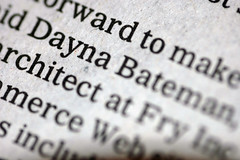
For those dear friends who showed an interest -- and who I suspect might even show up to see me in a parade in the rain (god bless you guys) -- here’s a link to the Bob Tedeschi piece as promised, which ran in this morning’s New York Times:
Do the Rights of the Disabled Extend to the Blind on the Web? by Bob Tedeschi in the New York Times.
Regrettably, the sound bite isn’t up the high-quoting quality standards subscribed to by this blog, so you won’t see it here – but it’s in there. Promise. (Of course, you’ve gotta know my name to get at it, now don’t ya?)
And I sound just a little bit more like a windbag than the last time Tedeschi asked me what I thought about something. (Which is probably not a good thing.)
Tedeschi writes about online accessibility for the blind -- the piece was spurred by a lawsuit against the Target Corp by the National Federation of the Blind, who claim that Target.com isn’t up ADA accessibility standards.
Much of online accessibility, just like real-world accessibility, is about Universal Design – making sure that everyone who wants to can get through the front door, navigate through the property and conduct their business there. Many times it’s as simple as choosing door handles over door knobs (metaphorically) – because more folks can operate door handles than knobs.
Other times it’s like adding Braille to signage (alt attributes behind img src html tags) or building a ramp to the front door (skip Flash intros; install a “skip nav” option for the long haul).
Online access for the blind means designing a site that can be easily read by a screen reader like Jaws; for some visual impairments it means being presented with a site that is high contrast or takes well to their operating system’s high contrast mode, and also allows for upping the display size of type; for the motor impaired it means being presented by a site with accommodating clickable footprints; for the deaf it means being able to access transcripts of audio components – I could go on, but you can see it means a lot of things to a lot of different people. All of whom should be kept in mind when the site is initially architected and production standards are defined because retrofitting can be time consuming and costly.
The U.S. government’s Section 508 requirements lay out what’s required by law under the ADA (anyone doing business with the government is required to abide by these) – and the W3C Web Accessibility Initiative goes the extra mile to define a slew of nice-to-haves that make things even more accommodating.
Stepping down off my soapbox now. Have a nice day. May it be accessible in every possible way.
;)
Update: Curtis Edmonds gave the piece a nice mention at Northbound: Google is Blind.
Update on 11.07.06: More commentary on the NYT piece at Blind Confidential: Web Access Questions and My Current Ennui






5 comments:
I knew you'd sound just like the smart girl you are -- brava!!
woo hoo!
Well done, friend!
Congratulations!! Excellent article too. Way back in the late 80's, I used to work as an Investigator for the state agency that handles discrimination complaints, including public accomodation complaints. It was always interesting to see how I could get a complaint to fall within the paramaters of the statute.
Back then the Internet didn't exist and until now, I never really looked at the Internet in terms of the ADA, but it does makes sense. This is really cutting edge law. Very exciting!
thanks, guys!
Anali: interesting that it's considered cutting edge -- it feels like it's slow in coming.
I worked on an account four years back where a lawsuit like this led to retrofitting a site to make it accessible -- given the legal precedent I expected things to snowball after that, but so little has happened since then.
Post a Comment